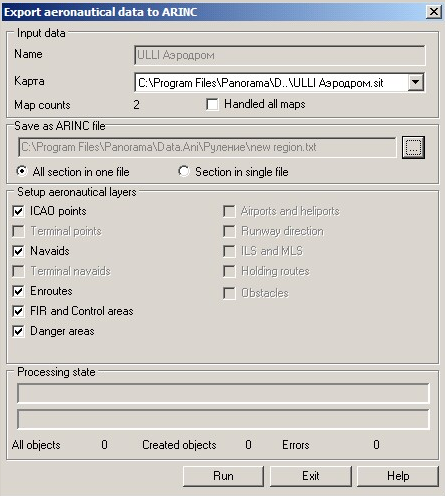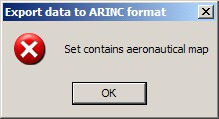Export from ARINC format |



|
|
This task is intended for formation of the aeronautical data in format ARINC-424 from aeronautical maps. The task is started from the menu "File\Export to...".
In the "Input data" field the processed map is selected. The drop-down list contains open maps which are created on the basis of the aeronautical classifier dfc.rsc. If aeronautical maps are absent the message on impossibility of the converter work is issued.
If several aeronautical maps will be available the flag "Handled all maps" will be enabled. In the drop-down list the input map is selected. After selecting a map there is executed the analysis of the availability of various objects categories of aeronautical information. Depending on outcome of analysis the flags will be available in the field "Setup aeronautical layers".
In the field "Save as ARINC file" by the button "…" the file name is selected. You can save different categories of objects into one file, or each category (section) into a separate file. In the mode "All sections in one file" all information from one or several maps is exported to a single file. Writing into a file is done sequentially by sections. In the mode of "Section in a single file" so many files will be created, how many categories are chosen in the field "Setup aeronautical layers". Each file will have a name chosen by the user, with the addition of the serial number. For example, if the file "C:\XXX\xxx.txt" is chosen then the formed files will have names "C:\XXX\xxx_1.txt", "C:\XXX\xxx_2.txt". In the field "Processing state" in the top line the total process of export is displayed. The percentage indicates how much of objects categories from the total number of selected categories is processed. Current processed category of objects is displayed in line «Processing state». The bottom line shows the percentage of the total export of the current categories of objects. Under the status-bar there are displayed the total number of objects for a category, number of created objects and number of objects with errors. The list of errors is stored in the log which is a text file. The journal is located in the LOG folder with the map, and has extension «.arinc.LOG». The name of the journal file corresponds to the name of file ARINC into which the export is carried out. Singularity of export's converter work: Formed text files correspond to ARINC Specification Version 424-18 and are intended for updating onboard navigation databases. Information corresponds to the following agreements: - all distances are given in tenths of nautical miles (1 NM = 1852 m); - all exceeding are specified in feet (1 ft = 0.31); - all heights are specified in flight levels (FLХХХ) or in feets; - coordinate system WGS84.
Completeness and quality of the resulting information depends on the completeness of filling the semantics of map objects. Objects that do not contain useful aeronautical information are ignored by the converter.
|


